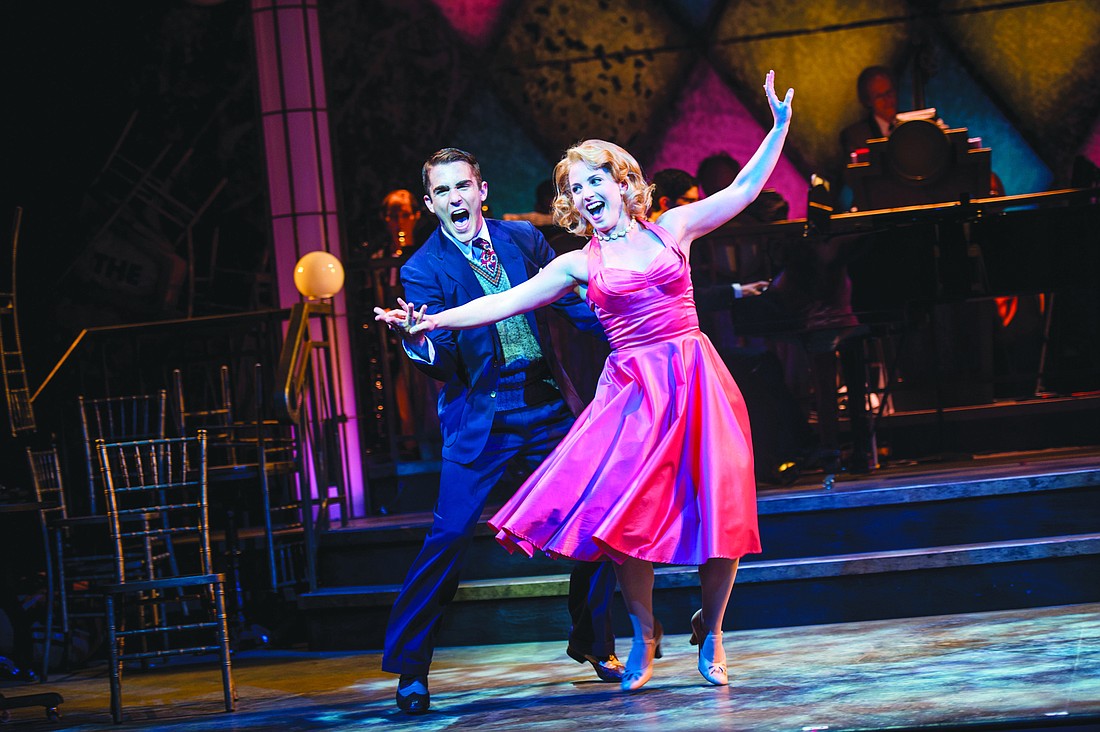- April 16, 2024
-
-
Loading

Loading

The problem with many musicals is the music. The songs have a job to do: set up character, plot, situation and back story. Job done, they’re instantly forgettable. Gordon Greenberg’s “Luck Be a Lady: The Iconic Songs of Frank Loesser” at the Asolo Rep, doesn’t have that problem. You’ll remember the songs. Chances are you knew them already. “Standing on the Corner,” “Luck Be a Lady,” and “Heart and Soul,” to name a few
This world-premiere musical dips into Loesser’s musical theater catalog and gives you the greatest hits. (Think of it as a jukebox musical raiding other musicals instead of a jukebox.) It takes the songs out of various stories and puts them in the context of a new story: Guy Meets Doll; Guy Loses Doll; Guy and Dame Get Back Together. This tale is told, sans dialog, with two actors playing the young couple, two others playing the couple in middle age.
The song and dance unfolds in a nightclub gone to seed. Dusty jukebox, chairs up on tables, a drop cloth-draped piano. (Excellent set design from Wilson Chin!) The Woman (Louise Pitre, the original Donna from “Mamma Mia!”) looks on in regret, then uncovers the piano and starts playing. “Heart and Soul,” of course — Loesser’s lyrics to Hoagy Carmichael’s tune. In a flash, chairs are set right, the jukebox comes to life, and a scrim flies away to reveal the band. Nobody spells it out, but it’s now the nightclub of memory. The Woman looks on as her younger self (Mary Michael Patterson) meets her first love (Erik Altemus). The regretful Man (W. Joseph Matheson) looks on too. The young lovers meet cute; the sadness of their older selves tell us it’ll end badly. The Eden-like nightclub has its own temptations — an unnamed rambling man (James David Larson) and the nightclub’s sultry songstress (Stephanie Umoh). The actors perform with heart. And, brother, can they sing
Greenberg directs the dream he created. His pacing is perfectly attuned to the ebb and flow of character development. It’s a tightly written show, but never too tight. He knows when to slow down and linger in moments of sadness or connection.
Music director Sinai Tabak (who’s also the pianist) keeps the six-piece band hopping to Neil Douglas Reilly’s inventive arrangements of Loesser’s tunes, including “Baby, It’s Cold Outside,” “If I Were a Bell,” “Once in Love with Amy,” “Happy to Keep His Dinner Warm” and “How’dja Like to Love Me” and “I Wish I Didn’t Love You So.” Most arrangements are swing-inflected, though “Spurs that Jingle” is downright country and “Traveling Light” is ready to rock. Denis Jones’ choreography flows out of the characters’ reality — with occasional sidesteps to fantasy land.
Reality or fantasy, love is what it’s all about. Greenberg’s original musical explores love’s permutations through the kaleidoscope of Loesser’s tunes. And what great tunes they are. This song list could easily have worked as a pure revue. Instead, Greenberg tackles a higher level of difficulty and gives us a storyline, too. It’s cleverly done, though occasionally forced. The musical’s structure shoehorns Loesser’s tunes into the narrative. They don’t always fit. “Big D” in particular sticks out like a sore thumb — breaking the narrative flow right before its organic conclusion.
But the cut-and-paste structure usually works. Loesser’s songwriting talent is why. His songs aren’t merely laying down plot points and getting the job done. They’re character driven — and fueled by what the characters feel. Loss, love, exuberance, hurt, you name it. Feelings burning in one character’s heart and soul, but also universal. (Songs about Dallas and jingling spurs being the exception.) Most of the time, you can pull Loesser’s songs out of one story and put them in another and they still work fine.
The result is a fine evening of theater — and one musical concoction after another. For Loesser fans, it’s like skipping dinner and eating dessert.